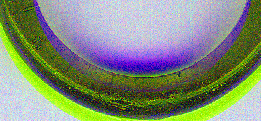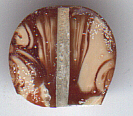Your path =Home>Beadmaking & Materials>Glass > Identifying

Bead Materials: Glass
Background
Glass beads are made with silica (usually from sand) in the glassy state. It is an early synthetic material and the premier bead material. Glass was invented in the Middle East some 4500 years ago. Its technology spread slowly, but by about 1000 BC it was being made in the Middle East, Europe, India and China.
Identification
Glass is sharp when knocked against your teeth. It can be scratched by a steel file but not a pen knife. It is not as cold to the touch as stone. If there is a chip it is conchoidal (shaped something like a ribbed clam).
Glass is sometimes confused with stone. The perforation is the key. Glass beads often have perforation deposits, either black (furnace-wound) or powdery (lamp-wound, see below). Stone beads are drilled, and you can feel the join of the drill with a pin.
|
__________________________________________________
Small Bead Businesses | Beading & Beadwork | Ancient Beads | Trade Beads
Beadmaking & Materials | Bead Uses | Researching Beads | Beads and People
Center for Bead Research | Book Store | Free Store | Bead Bazaar
Shopping Mall | The Bead Auction | Galleries | People | Events
The Bead Site Home | Chat Line | Contact Us | Site Search Engine | FAQ



